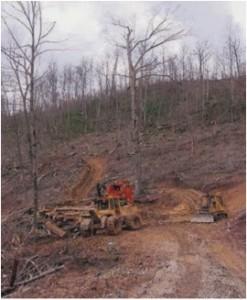BACKGROUND: A logging crew was clearcutting a hollow in the Appalachians. The hollow was to be used as a hollowfill for an impending surface mine. The crew was in somewhat of a rush to get the timber removed before mining operations began.
PERSONAL CHARACTERISTICS: The manager of the logging job had nearly 20 years of experience logging in the Appalachians.
UNSAFE ACT OR CONDITION: The knuckleboom loader and log landing were set up directly under a large, hollow beech tree that contained several dead branches. The loggers also cut several feet of dirt away from the lower side of the tree when constructing a skid road into the landing. Although a forester had pointed out the dangerous tree, the loggers did not want to take time to remove it or to relocate the landing.
ACCIDENT: During a storm at night, a large branch, 10 to 12 inches in diameter, broke out of the top of the tree. It narrowly missed the knuckleboom and fell on the log pile.
INJURY: Fortunately the limb fell while no one was on the site. It could have struck and killed someone, and it could have severely damaged the knuckleboom or other equipment.
RECOMMENDATIONS FOR CORRECTION: Look for hazard trees around the landing and on the entire logging job. OSHA requires that “each danger tree shall be felled, removed, or avoided” before harvesting begins. If hazardous trees cannot be safely removed, avoid the area and use caution tape or flagging to alert others to the danger. It can be tempting to set up a landing under a “shade tree” in summer months. If this is done, be certain the tree is sound, and that skid roads do not affect its stability. Also be aware of other overhead dangers, such as utility lines, in locating a landing.
Courtesy of the Forest Resources Association: https://www.forestresources.org/

